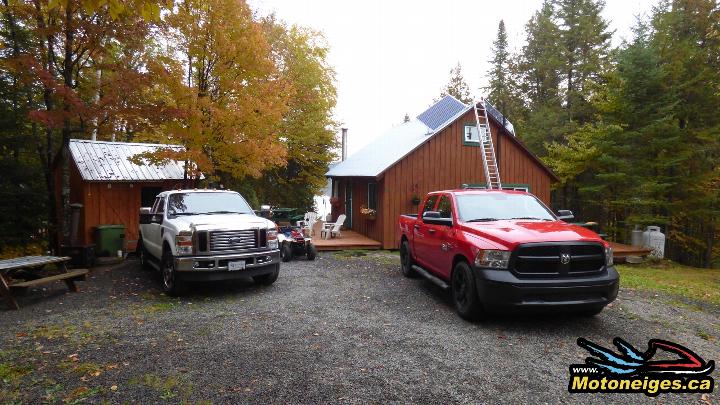
Cabin with solar panels.
Snowmobilers and quadists who go to their cabin on their off-road vehicle can enjoy improved comfort since the introduction of solar energy. Effectively, this type of free energy coming from the sun does not require to be transported, piled up, dried out or stored in pressurized tanks. Solar energy powered equipments are an advantageous innovation for owners of cottage and cabin in backcountry.

Energy source available everywhere and all year long

Even in winter, batteries keep their full charge
However, some cottagers who are fans of gas and wood, are still not sure about solar energy because they do not know exactly what installation is required to meet their needs. This article is meant to help you define your energy needs and to establish exactly your cottage location so that you will be able to discuss with an expert who will then have a better understanding of your situation and who will suggest the adequate equipment to meet your real needs and expectations.
Calculation required for a proper functional installation
Firstly, we need to determine where the solar panels will be installed on the site in order to optimize their orientation and height for optimal sunshine. The ideal orientation is due south but sometimes, there are some restrictions that make us rather use eastward morning sun or westward afternoon sun.

The optimal orientation is due south
Solar panels can be installed on a pole or a roof, or at any place where they will face sunshine the longest. They must be oriented southward and installed high enough to receive the short sunshine hours of winter months.
For best results, the panels must be placed at 90° with sunlight and it is why some systems let you adjust the angle of the solar panels during months when sun is at its lowest position. This raised angle also allows the snow to slide. Another way to determine the optimal angle of a solar panel is to take the latitude of your cabin site and to substract 10° in summer and to add 10° in winter. For example, La Tuque latitude is 47°. So, solar panels will be set at 37° in summer and raised at 57° in winter to keep an angle of 90° with the sun. However, an angle of 47° remains the fixed position that will provide good supply anyway. Also, you can get a device operated by solar energy that makes panels move to follow the sun position, just as sunflowers do.

Sunflowers follow the sun movements all day long for optimal benefits. It is possible to do so with solar panels and the device is called solar tracker..
Once the optimal location is planned, you must determine the number of hours of sunshine that will hit the panels each day. If the cabin or cottage is used in winter, when the sun is at its lowest (November, December, January), you must check the best height of the solar panels in order to avoid obstacles between them and the sun. Dense wood, tall spruce or mountain that bring shadow on solar panels will impact the daily recharge of the batteries and their power accumulated and available. You must avoid these obstacles that hide the sun from the panels during some time. It is energy lost.
Checking your cabin or cottage surroundings will help you determine what you need when you will visit the solar energy expert : number of solar panels, their type of supports, their capabilities, the type of installation, the power of the charge controller and the number of batteries required. You will have to get enough batteries to make sure your reserve can supply your refrigirator, lighting, water pump, ceiling fan, in brief, enough to meet your needs.

The controller located between panels and batteries, the digital display that shows the charging, the consumption and the load of AMP/Hour in batteries..

The whole system, the controller and its protection breaker, the digital display, the 6V deep-cycle batteries in a case, boxes of breakers for distribution to lamps and 12V devices.
Solar energy supply allows the use of many equipments : so, you must evaluate…

LED ceiling lamp that uses 0,6 AMP/Hour

Another type of ceiling lamp that uses 0,5 AMP/Houre
The installation in the cabin of lighting with LED lamps that will be safer, greener and more user friendly, will replace for the best the gas or kerosene lamps. Also, this type of 12V lighting brings much luminosity while taking low energy from your batteries.
Remember that in winter, sunny days being shorter, we use more lighting and other equipments. There must be enough load in the batteries to meet your needs.
For example, here is a list of data about the calculation of your needs for a solar energy installation that will help you determine yours.
- A full-size operational 12V refrigerator can require 2,6 AMP/Hour, multiplied by 24 hours.
- A satellite Sirius radio and its boom box uses 1 AMP/Hour, multiplied by the usual number of hours in use.
- A LED lighting or ceiling lamp uses 0,5 AMP/Hour. So, 3 lamps will require 1,5 AMP/Hour, to be multiplied by the number of hours in use. Please note that the fluo-compact lamps (pig tails) use more energy than LED lamps and are do not stand cold temperatures.
- A 12V ceiling fan of 42 in. / 106,8 cm uses 0,5 AMP/Hour and moves 1500 CFM.
- A 12V SHURflo water pump uses about 5,6 AMP/Hour and pumps 3,6 gal/min. If the total of functionning hours is 3/day for showers, dishes, WC, you must consider the energy used and add it all.
- Use of radio, TV, ceiling fan and other equipments requires that you consider the number of hours when they are usually functionning.
- Recharging small devices that use rechargeable batteries from a 12V outlet (cellphone, computer, pad) also uses energy. You must take this into consideration when looking for the adequate system.

Adding panels to supply more equipments

12V water pumps are efficient enough and function on demand.

Ceiling fans distribute very well the heat coming from the woodstove and keep floors warmer. In summer, they help cooling the place
So, before buying anything, we must determine our needs of energy, the charges we will need in batteries and finally, the power in watt of the panels and controller that during sunny hours at the cabin, will supply each day full power to our batteries. If we begin with a system that is too small, we will have to change the controller for more panels, to increase the number of batteries for larger reserve. Also, new batteries do not fit with batteries that are already a few years old. In brief, additional costs that could be avoided by a proper pre-analysis of your needs.

Reserve of eight 6V batteries
When used and recharged the right way, and when verified from time to time, the batteries will last from 5 to 8 years and then, will have to be replaced.
A small generator and a good 45 AMP power station as found in recreational vehicles, will help balance it all if we occasionnally use more energy than available in our batteries and supplied by the panels.
Why a 12V refrigerator at the camp or cottage?

The new 12V refrigerators
Why? Because it is as much reliable and efficient than the electric refrigerator at home.
Because with solar energy, there will be no cost anymore. A propane refrigerator uses from 1 ¼ and 1 ¾ lb of propane per day. Free green energy is available everywhere.
For the same cubic volume, the purchase is much less expensive than a gas refrigerator and it is easy to install.
No hazardous product to buy, to transport in cylinders or to have delivered at the cottage.
No risk of carbon monoxyde emission inside the cottage (the silent killer). No combustion, no monoxide. No pollution.
No chimney required through the walls to evacuate outside since there is no combustion. Also, no cold air return inside through the chimney.
We eliminate the possible leaks of propane inside after a sudden breakage. No gas odor (methyl mercaptan or rotten-eggs), no risk of intoxication or failure that could endanger people safety and health. In winter, camps are much less ventilated and we must be even more careful with gas equipments.
No annual cleaning required of the smoke duct, the burner, no ashes to pick up or other residues on and around the burner that could be a danger or could break. In brief, with the 12V, a clean refrigerator with no residue.
The solar energy, a natural product, free and not taxed yet except for the purchase of the equipment. Why not enjoy it at the cabin or at the cottage?
Well, snowmobilers and quadists, enjoy winter and then, get warm near your woodstove with power provided by the sun.
Special thanks to Pierre Tremblay, from Batteries des Récollets, and IDS Énergie also from Trois-Rivières, for their wise advices.

Comfort at the cabin


